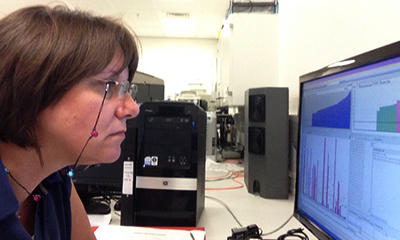Kay Poulton, Consultant Clinical Scientist in Histocompatibility and Immunogenetics
Each year, around 5,000 organ transplants and 17,002 bone marrow transplants give those with severe illnesses a chance at a new life. These transplants would be impossible were it not for the work of scientists in histocompatibility and immunogenetics – otherwise known as H&I. We speak to Kay Poulton about her work in this specialty.
First, tell us a bit more about your specialty…
Histocompatibility is the study of the immunological reactions involved in transplantation and how we can use our knowledge of these to predict transplant outcome or monitor a patient’s response to a transplant. Mostly, this involves analysing molecules known as Human Leucocyte Antigens (HLA), which are expressed on all our cells and give each of us an individual “molecular fingerprint”, or “tissue type”. It’s possible for the immune system to generate antibodies to “non-self” HLA antigens which would cause transplant rejection and it’s therefore critical to characterise these thoroughly to maximise the chance of the organ surviving.
Immunogenetics is the study of any genes encoding molecules involved in the immune response, including HLA genes. Even single base differences at the genetic level can have an enormous impact on transplant outcome. Sometimes, HLA antigens are associated with susceptibility to autoimmune diseases or adverse drug reactions, so some of our work involves supporting diagnosis or therapeutic programmes.
What do consultant clinical scientists in H&I do?
Consultant clinical scientists in H&I oversee testing in the lab and provide critical interpretation of results and associated scientific and clinical advice so that transplants and transfusions can take place. They work closely with other scientists, doctors and nurses in transplant units – particularly transplant coordinators, who oversee the patient’s journey from in-take to aftercare.
Transplantation is a round-the-clock process, with tests needing to be done overnight, so often they need to prioritise urgent tests to ensure effective service provision. Whilst they’re unlikely to have a great deal of patient contact, they get to know individual patients very well, through pre and post-transplant testing – and through their involvement multidisciplinary team meetings.
What does a typical day look like for you?
Transplantation is a round-the-clock process, so often my day has already started before I leave for work in the morning.
As I arrive in work my first job is to check that any testing performed during the night is in order, and any testing due during the day can go ahead as quickly as possible. My job is to provide advice to the clinical teams performing the transplants to ensure that they are safe to proceed. HLA typing for potential donors or matching assessments will have been performed as a matter of urgency whenever the need arises.
My afternoons are spent discussing our cases in multidisciplinary team meetings, and exploring all options for patients who are difficult to match. Transplant matching needs careful discussion with everybody involved in the care of the patient. Some kidney transplants are planned routinely using living donors, and bone marrow donors can be matched with their recipients during the working day. Sometimes patients begin to reject their grafts, and a huge amount of our work involves carrying out tests to help the clinicians to manage the rejection process and keep the new organ working properly.
Why did you choose this specialty?
I liked the idea that the clinicians and scientists who made the early discoveries of the HLA system were not only still around, but very approachable. The H&I community is essentially a worldwide network of laboratories working very closely together to implement new discoveries as quickly as possible. The science is very exciting and we’re still learning about how to improve transplantation.
What do you enjoy most about your job?
Transplantation gives people their lives back when all hope is lost. For my contribution, I want each patient to have the very best graft we can get, and for it to give them a long, healthy life.
What advice would you give to students looking to enter your field?
To do well in this job, you need to be the sort of person who can think fast and draw on your knowledge to solve complex problems because every case is different. If possible, approach your local H&I laboratory and go for a visit. You may even be able to do some voluntary work there to check that it is right for you. This really is a 24-hour job, and you need to be happy with that, but the rewards are fantastic when you meet the patients and realise that you had a part in making them better.
Do you take part in anything on top of your ‘day to day’ work in the lab?
I’ve recently been involved with writing Standards for H&I testing for Europe and the USA. At the moment, I’m the Chair of our national society, the British Society for Histocompatibility and Immunogenetics and I’m a board member of the European Federation for Immunogenetics. Mostly, any extra work is done in my own time or at weekends, but these positions give me an opportunity to pick up on new developments quickly so that I can put them into practice for our patients. It’s also been a great way of extending my own network, and means that if we have a problem in our laboratory, I can “phone a friend” for advice or collaboration. There’s usually expertise somewhere in the world to support us!
